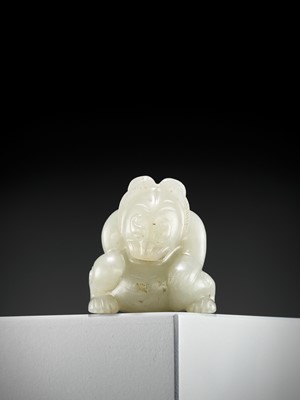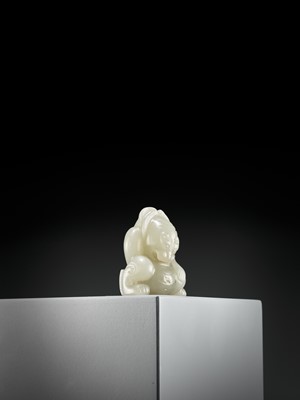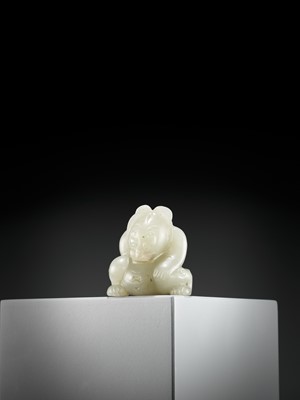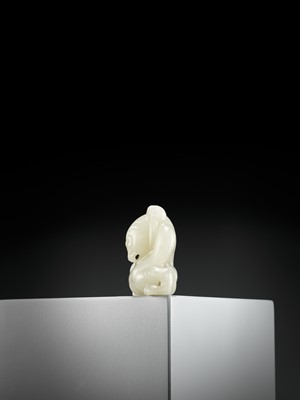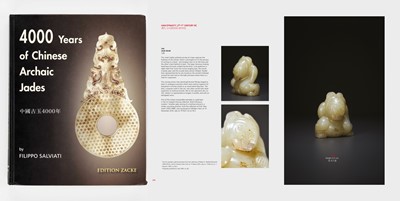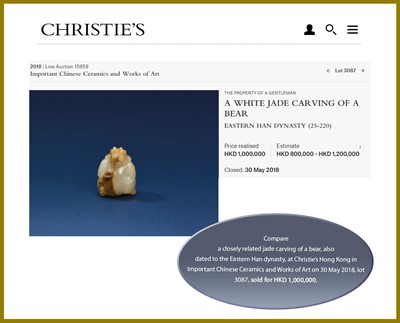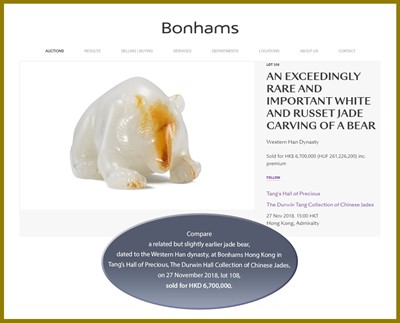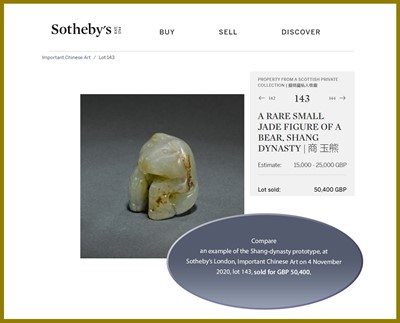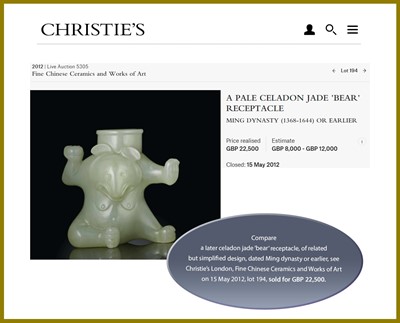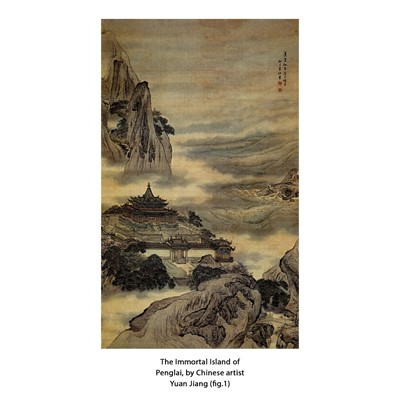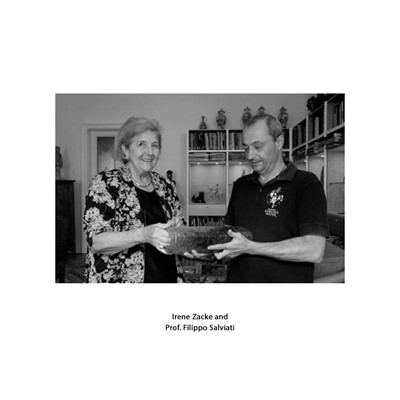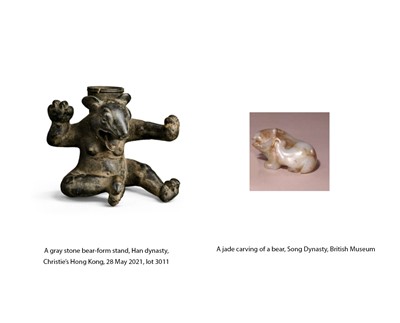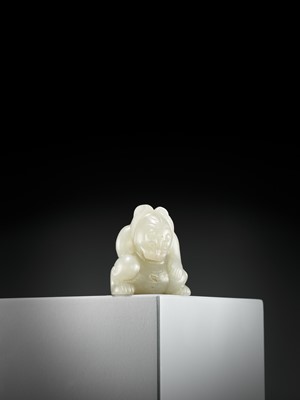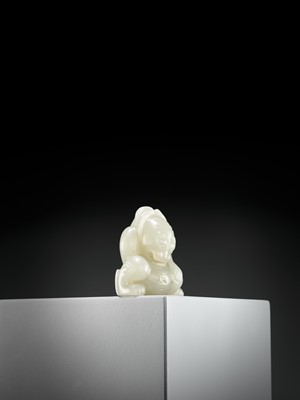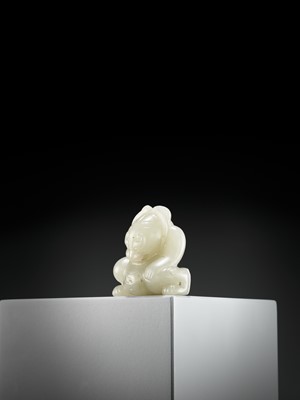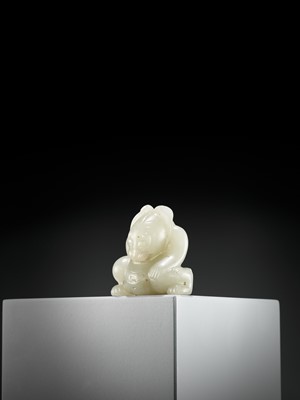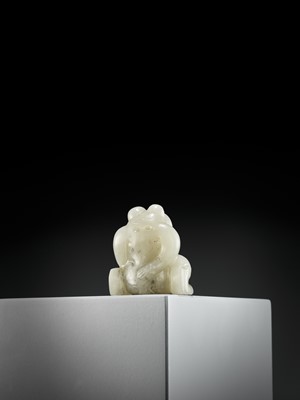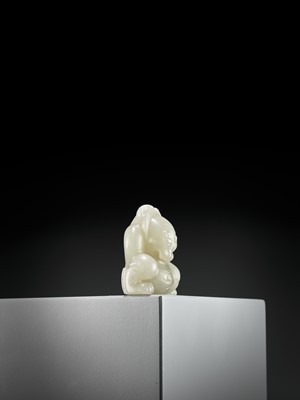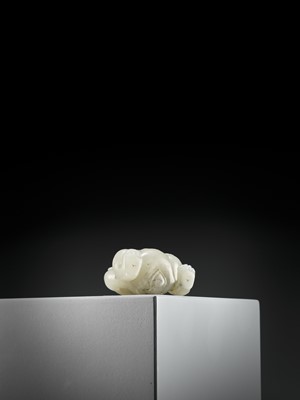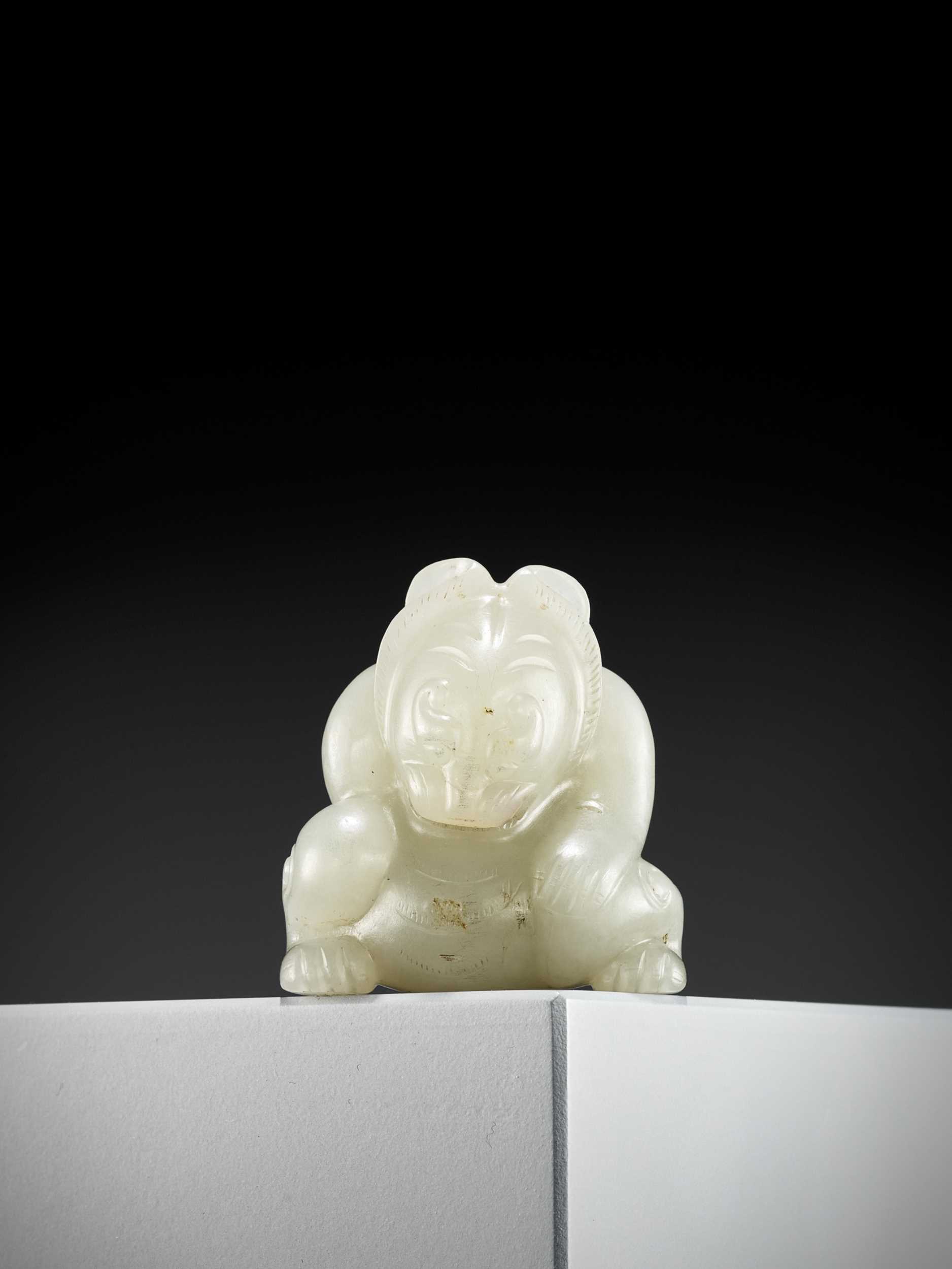15th Oct, 2021 10:00
TWO-DAY AUCTION - Fine Chinese Art / 中國藝術集珍 / Buddhism & Hinduism
77
A PALE CELADON JADE FIGURE OF A BEAR, EASTERN HAN DYNASTY
東漢灰白玉雕熊
Sold for €27,808
including Buyer's Premium
China, 25-220 AD. Finely carved as a squatting bear with bent knees and slightly protruding belly, one hand resting on its knee, scratching its behind with the other. The face with a fierce expression and finely detailed with bulging eyes below scrolling brows, the mouth pierced. The back with two small cord holes.
Provenance: The Private Collection of Irene and Wolfgang Zacke. The couple has been active in the art trade for well over half a century and were one of the first in Austria to offer Asian works of art for sale, starting in 1968. Since the late 1980s, they have been collecting ancient Chinese jades, building an extensive collection over the decades.
Published: 4000 Years of Chinese Archaic Jades, Prof. Filippo Salviati, 2017, page 346, no. 344.
Condition: Good condition with minor old wear and few signs of weathering and erosion, shallow surface scratches, few tiny losses. The stone with natural fissures, some of which may have developed into small hairline cracks over time. The two small cord holes at the backside, although neatly bored and masterly polished, are possibly a later addition.
Weight: 50.9 g
Dimensions: Height 4.4 cm, Width 4 cm
The translucent stone of a pale celadon tone with scattered dark-brown and cloudy-white inclusions as well as some grayish hues to the backside. The surface with a silky matte finish.
In ancient China immortality was often considered the ultimate pursuit for royalty. The First Emperor who united the country in 221 BC is known to have sent expeditions into the eastern sea in search of Penglai (fig.1), a mountainous island shrouded in a mysterious cloud, which at the time was believed to be the home of immortals, where elixirs of immortality could be retrieved. Once every 99th year, an immortal from this mysterious island would descend to the earthly realm and bestow immortality upon a select few. These immortals were believed to take the form of carved jade animals, for example bears.
Jade was the only material in which these mythological epitomes were believed to exist. This conviction is probably due to the near-indestructible quality of the mineral, which would make such a carving outlive every human being. When inhabited by an immortal, the jade would have looked almost fully translucent, especially when held against strong moonlight. According to ancient creed, the owner of such a magical jade animal was ensured an extended life. By having everyday contact with the object through rubbing its surface, the power of the inhibiting immortal would slowly be transferred to its owner. Highly sought after by the rich and wealthy, a jade animal as such was extremely rare and thus widely copied throughout Chinese history, particularly during the Song and Ming dynasties.
Literature comparison: Compare a related gray stone bear-form stand, dated to the Han dynasty, but of larger size (22.8 cm), at Christie’s Hong Kong, 28 May 2021, lot 3011. Also compare a jade bear dated to the Song dynasty at the British Museum, accession number 1947,0712.487, described as "Figure of a bear. The animal is crouching on the ground, head turned sideways, jaw open, towards the viewer. The proper rear left leg is lifted to scratch behind its ear. Made of jade.”
Auction result comparison: Compare a closely related jade carving of a bear, also dated to the Eastern Han dynasty, at Christie’s Hong Kong in Important Chinese Ceramics and Works of Art on 30 May 2018, lot 3087, sold for HKD 1,000,000, and a related but slightly earlier jade bear, dated to the Western Han dynasty, at Bonhams Hong Kong in Tang’s Hall of Precious, The Durwin Hall Collection of Chinese Jades, on 27 November 2018, lot 108, sold for HKD 6,700,000. For an example of the Shang-dynasty prototype, see Sotheby’s London, Important Chinese Art on 4 November 2020, lot 143, sold for GBP 50,400, and for a later celadon jade ‘bear’ receptacle, of related but simplified design, dated Ming dynasty or earlier, see Christie’s London, Fine Chinese Ceramics and Works of Art on 15 May 2012, lot 194, sold for GBP 22,500.
東漢灰白玉雕熊
中國, 25-220 年。玉熊稍成蹲式,屈膝,腹部圓鼓,一手扶膝,一手抓背。 臉部表情兇惡、細節生動,捲曲的眉毛下雙眼凸出,嘴巴被刺穿。 背面有兩個小繩孔。
來源:Irene 與Wolfgang Zacke收藏。這對夫妻一直活躍於藝術品行業已有半個多世紀,自1968年起他們開始在奧地利經營亞洲藝術品,是最早的商人之一。自1980年代後期以來,他們一直在收集中國古玉,數十年來建立了一個大規模的收藏。
出版:《中國古玉4000年》,Prof. Filippo Salviati, 2017, 第346頁,圖344。
品相:品相良好,舊時小磨損,少量風化侵蝕痕跡,表面有淺淺的劃痕,輕微小缺損。 具有天然裂縫的石料,隨著時間的推移,其中一些脈理可能會發展成細小的裂縫。 背面的兩個小繩孔雖然經過整齊的鑽孔和巧妙的拋光,但可能是後來添加的。
重量:50.9 克
尺寸:高4.4 厘米, 寬 4 厘米
拍賣結果比較:一件東漢玉熊,見香港佳士得Important Chinese Ceramics and Works of Art 2018年5月30日 lot 3087, 售價HKD 1,000,000, 一件更早的玉熊,可能爲西漢,見香港邦翰思Tang’s Hall of Precious, The Durwin Hall Collection of Chinese Jades 2018年11月27日 lot 108, 售價HKD 6,700,000。 一件商代原型﹐見倫敦蘇富比Important Chinese Art 2020年11月4日 lot 143, 售價GBP 50,400, 一件明代或更早的青玉熊﹐見倫敦佳士得Fine Chinese Ceramics and Works of Art 2012年5月 15日 lot 194, 售價GBP 22,500。
China, 25-220 AD. Finely carved as a squatting bear with bent knees and slightly protruding belly, one hand resting on its knee, scratching its behind with the other. The face with a fierce expression and finely detailed with bulging eyes below scrolling brows, the mouth pierced. The back with two small cord holes.
Provenance: The Private Collection of Irene and Wolfgang Zacke. The couple has been active in the art trade for well over half a century and were one of the first in Austria to offer Asian works of art for sale, starting in 1968. Since the late 1980s, they have been collecting ancient Chinese jades, building an extensive collection over the decades.
Published: 4000 Years of Chinese Archaic Jades, Prof. Filippo Salviati, 2017, page 346, no. 344.
Condition: Good condition with minor old wear and few signs of weathering and erosion, shallow surface scratches, few tiny losses. The stone with natural fissures, some of which may have developed into small hairline cracks over time. The two small cord holes at the backside, although neatly bored and masterly polished, are possibly a later addition.
Weight: 50.9 g
Dimensions: Height 4.4 cm, Width 4 cm
The translucent stone of a pale celadon tone with scattered dark-brown and cloudy-white inclusions as well as some grayish hues to the backside. The surface with a silky matte finish.
In ancient China immortality was often considered the ultimate pursuit for royalty. The First Emperor who united the country in 221 BC is known to have sent expeditions into the eastern sea in search of Penglai (fig.1), a mountainous island shrouded in a mysterious cloud, which at the time was believed to be the home of immortals, where elixirs of immortality could be retrieved. Once every 99th year, an immortal from this mysterious island would descend to the earthly realm and bestow immortality upon a select few. These immortals were believed to take the form of carved jade animals, for example bears.
Jade was the only material in which these mythological epitomes were believed to exist. This conviction is probably due to the near-indestructible quality of the mineral, which would make such a carving outlive every human being. When inhabited by an immortal, the jade would have looked almost fully translucent, especially when held against strong moonlight. According to ancient creed, the owner of such a magical jade animal was ensured an extended life. By having everyday contact with the object through rubbing its surface, the power of the inhibiting immortal would slowly be transferred to its owner. Highly sought after by the rich and wealthy, a jade animal as such was extremely rare and thus widely copied throughout Chinese history, particularly during the Song and Ming dynasties.
Literature comparison: Compare a related gray stone bear-form stand, dated to the Han dynasty, but of larger size (22.8 cm), at Christie’s Hong Kong, 28 May 2021, lot 3011. Also compare a jade bear dated to the Song dynasty at the British Museum, accession number 1947,0712.487, described as "Figure of a bear. The animal is crouching on the ground, head turned sideways, jaw open, towards the viewer. The proper rear left leg is lifted to scratch behind its ear. Made of jade.”
Auction result comparison: Compare a closely related jade carving of a bear, also dated to the Eastern Han dynasty, at Christie’s Hong Kong in Important Chinese Ceramics and Works of Art on 30 May 2018, lot 3087, sold for HKD 1,000,000, and a related but slightly earlier jade bear, dated to the Western Han dynasty, at Bonhams Hong Kong in Tang’s Hall of Precious, The Durwin Hall Collection of Chinese Jades, on 27 November 2018, lot 108, sold for HKD 6,700,000. For an example of the Shang-dynasty prototype, see Sotheby’s London, Important Chinese Art on 4 November 2020, lot 143, sold for GBP 50,400, and for a later celadon jade ‘bear’ receptacle, of related but simplified design, dated Ming dynasty or earlier, see Christie’s London, Fine Chinese Ceramics and Works of Art on 15 May 2012, lot 194, sold for GBP 22,500.
東漢灰白玉雕熊
中國, 25-220 年。玉熊稍成蹲式,屈膝,腹部圓鼓,一手扶膝,一手抓背。 臉部表情兇惡、細節生動,捲曲的眉毛下雙眼凸出,嘴巴被刺穿。 背面有兩個小繩孔。
來源:Irene 與Wolfgang Zacke收藏。這對夫妻一直活躍於藝術品行業已有半個多世紀,自1968年起他們開始在奧地利經營亞洲藝術品,是最早的商人之一。自1980年代後期以來,他們一直在收集中國古玉,數十年來建立了一個大規模的收藏。
出版:《中國古玉4000年》,Prof. Filippo Salviati, 2017, 第346頁,圖344。
品相:品相良好,舊時小磨損,少量風化侵蝕痕跡,表面有淺淺的劃痕,輕微小缺損。 具有天然裂縫的石料,隨著時間的推移,其中一些脈理可能會發展成細小的裂縫。 背面的兩個小繩孔雖然經過整齊的鑽孔和巧妙的拋光,但可能是後來添加的。
重量:50.9 克
尺寸:高4.4 厘米, 寬 4 厘米
拍賣結果比較:一件東漢玉熊,見香港佳士得Important Chinese Ceramics and Works of Art 2018年5月30日 lot 3087, 售價HKD 1,000,000, 一件更早的玉熊,可能爲西漢,見香港邦翰思Tang’s Hall of Precious, The Durwin Hall Collection of Chinese Jades 2018年11月27日 lot 108, 售價HKD 6,700,000。 一件商代原型﹐見倫敦蘇富比Important Chinese Art 2020年11月4日 lot 143, 售價GBP 50,400, 一件明代或更早的青玉熊﹐見倫敦佳士得Fine Chinese Ceramics and Works of Art 2012年5月 15日 lot 194, 售價GBP 22,500。
Zacke Live Online Bidding
Our online bidding platform makes it easier than ever to bid in our auctions! When you bid through our website, you can take advantage of our premium buyer's terms without incurring any additional online bidding surcharges.
To bid live online, you'll need to create an online account. Once your account is created and your identity is verified, you can register to bid in an auction up to 12 hours before the auction begins.
Intended Spend and Bid Limits
When you register to bid in an online auction, you will need to share your intended maximum spending budget for the auction. We will then review your intended spend and set a bid limit for you. Once you have pre-registered for a live online auction, you can see your intended spend and bid limit by going to 'Account Settings' and clicking on 'Live Bidding Registrations'.
Your bid limit will be the maximum amount you can bid during the auction. Your bid limit is for the hammer price and is not affected by the buyer’s premium and VAT. For example, if you have a bid limit of €1,000 and place two winning bids for €300 and €200, then you will only be able to bid €500 for the rest of the auction. If you try to place a bid that is higher than €500, you will not be able to do so.
Online Absentee and Telephone Bids
You can now leave absentee and telephone bids on our website!
Absentee Bidding
Once you've created an account and your identity is verified, you can leave your absentee bid directly on the lot page. We will contact you when your bids have been confirmed.
Telephone Bidding
Once you've created an account and your identity is verified, you can leave telephone bids online. We will contact you when your bids have been confirmed.
Classic Absentee and Telephone Bidding Form
You can still submit absentee and telephone bids by email or fax if you prefer. Simply fill out the Absentee Bidding/Telephone bidding form and return it to us by email at office@zacke.at or by fax at +43 (1) 532 04 52 20. You can download the PDF from our Upcoming Auctions page.
How-To Guides
How to Create Your Personal Zacke Account
How to Register to Bid on Zacke Live
How to Leave Absentee Bids Online
How to Leave Telephone Bids Online
中文版本的操作指南
创建新账号
注册Zacke Live在线直播竞拍(免平台费)
缺席投标和电话投标
Third-Party Bidding
We partner with best-in-class third-party partners to make it easy for you to bid online in the channel of your choice. Please note that if you bid with one of our third-party online partners, then there will be a live bidding surcharge on top of your final purchase price. You can find all of our fees here. Here's a full list of our third-party partners:
- 51 Bid Live
- EpaiLive
- ArtFoxLive
- Invaluable
- LiveAuctioneers
- the-saleroom
- lot-tissimo
- Drouot
Please note that we place different auctions on different platforms. For example, in general, we only place Chinese art auctions on 51 Bid Live.
Bidding in Person
You must register to bid in person and will be assigned a paddle at the auction. Please contact us at office@zacke.at or +43 (1) 532 04 52 for the latest local health and safety guidelines.
